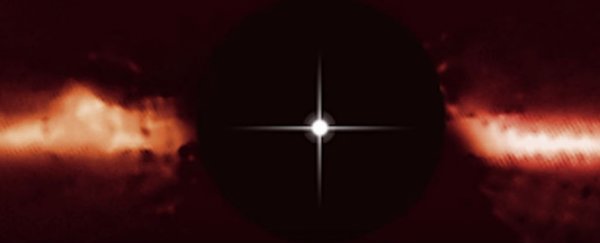There's something strange and unlike anything we've ever seen or predicted speeding around one of Earth's neighbouring stars.
When astronomers pointed the Very Large Telescope (VLT) in Chile at the star called AU Mic, they spotted something in its surrounding dust cloud that they have never seen before - giant waves of rippling dust speeding away from the star's centre. You can see the waves in red in the image above.
Astronomers often study dust clouds (called discs) around stars because they provide valuable clues about how planets form. Clumps in the cloud usually reveal the location of planets. But when astronomers mounted a new instrument on VLT called SPHERE and pointed it at AU Mic, they spotted something very different than simple clumps of dust.
"Our observations have shown something unexpected," said lead author on the new research paper Anthony Boccaletti. "The images from SPHERE show a set of unexplained features in the disc which have an arch-like, or wave-like, structure, unlike anything that has ever been observed before."
There are five of these strange waves. They look like ripples in a pool of water:
 ESO
ESO
When Boccaletti and his team compared the image to those taken in previous years, they discovered something even more surprising: The ripples are moving, and moving really fast. At least three of them are moving at around 25,000 miles per hour (40,000 km/h) - that's fast enough for them to start escaping from the star's gravitational pull.
Astronomers aren't sure what's causing the new features to move at breakneck speed. AU Mic regularly ejects huge bursts of stellar energy from its surface, so it's possible an especially large flare was powerful enough to push the ripples of dust away from the star and out into the cosmos. We'll need more data before astronomers know for sure. The new research was published in the journal Nature on October 7.
In other space news NASA's New Horizons spacecraft, which visited Pluto in July, has just returned the first colour images of the world's atmospheric haze, and it has a brilliant blue tint. This comes after New Horizons scientists made a surprising discovery of patches of water ice on the surface. Read more on that here.

This article was originally published by Business Insider.
More from Business Insider:
